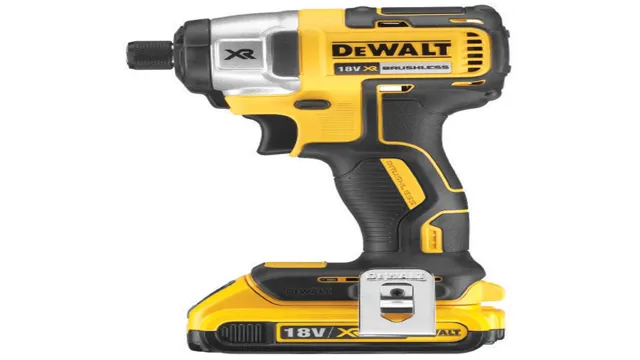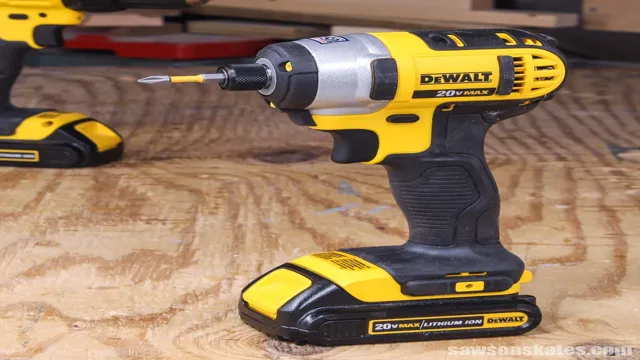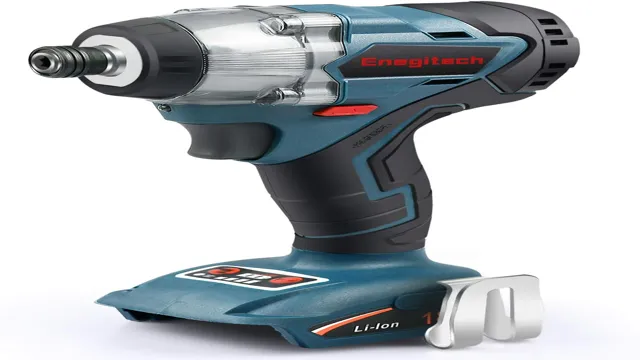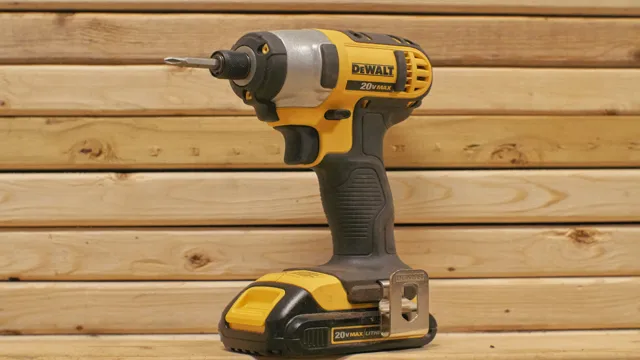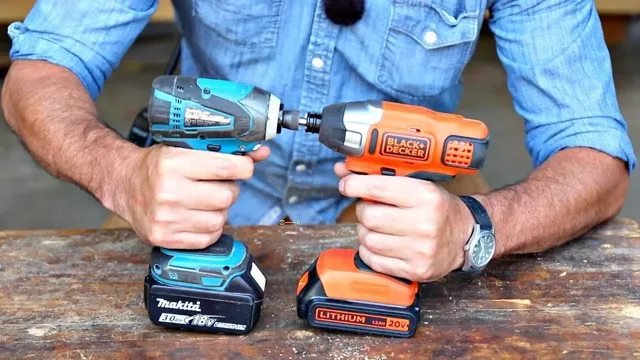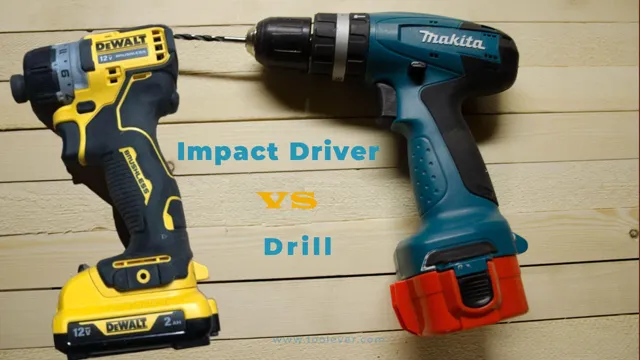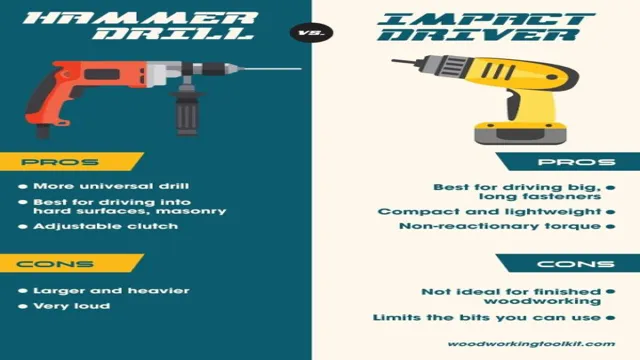Can I Use Impact Driver for Concrete? The Answer You Need to Know!
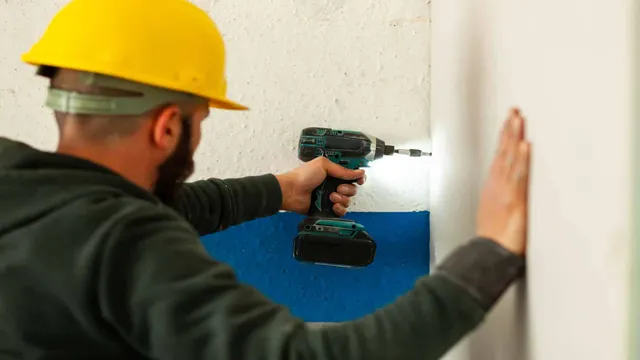
Have you ever wondered if using an impact driver for concrete is possible? The answer is yes! While traditionally used for driving screws and bolts, an impact driver can also be used for drilling holes in concrete. While it may not be the most conventional method, an impact driver can be a handy tool to have on hand when a drill is unavailable or not strong enough for the job. An impact driver operates by delivering a high amount of torque in short bursts, making it ideal for driving fasteners into tough or stubborn materials.
When used with a masonry bit, an impact driver can create holes in concrete with ease. However, it is important to note that an impact driver may not be as precise as a traditional hammer drill, and caution should be taken to avoid damaging the concrete or creating irregular holes. Overall, using an impact driver for concrete can be an efficient way to tackle small projects or unexpected tasks on the job site.
Whether you’re a professional tradesperson or a dedicated DIY enthusiast, having an impact driver in your arsenal can make a big difference in how you approach your work.
Understanding the Role of an Impact Driver
While an impact driver can be a versatile tool for various DIY projects, it may not be the best tool for concrete. An impact driver is designed to provide high torque and rotational force, making it effective for tasks like driving screws and bolts. However, concrete requires a different type of tool as it is a much denser material.
A rotary hammer drill is the recommended tool for drilling into concrete as it provides the necessary pounding action to break through the hard surface. While an impact driver may be able to create holes in concrete, it may take longer and cause damage to the tool, making it not worth the effort. Therefore, if you need to work with concrete, it’s best to invest in a rotary hammer drill for the job.
Definition and Function of an Impact Driver
An impact driver is a power tool that exerts a rotational force in short bursts to drive screws and other fasteners into hard materials such as wood, metal, and concrete. Impact drivers deliver high torque output, making them suitable for heavy-duty tasks that require more power and precision than a regular drill can provide. These tools employ a specialized mechanism that generates a rapid series of impacts as the driver rotates.
As a result, an impact driver can drive screws faster and more smoothly than other tools, reducing the risk of stripped screws and enhancing work efficiency. Think of it like a hammer, which delivers a series of blows to a nail to make sure it’s driven deep into the wood. An impact driver applies the same principle, but instead of using brute force, it uses a series of quick bursts of rotational force to drive fasteners with greater accuracy.
If you want to make your DIY projects or construction work more manageable and efficient, an impact driver is an indispensable tool that you should consider investing in.
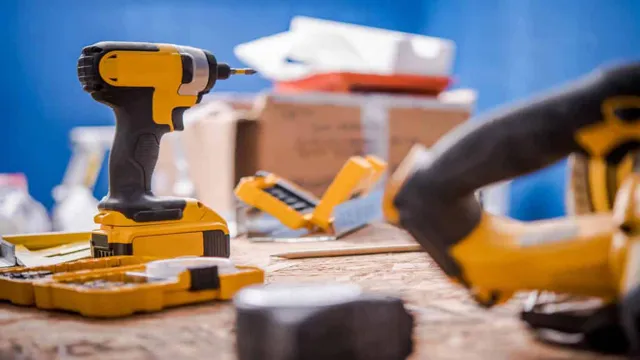
Types of Impact Drivers
An impact driver is a powerful tool that is typically used in construction, woodworking, and metalworking projects. It is designed to deliver high torque output with minimal effort from the user. Impact drivers are capable of driving screws and bolts into tough materials like hardwood, concrete, and sheet metal.
There are several types of impact drivers to choose from, including corded and cordless options. Corded impact drivers deliver consistent power output but are less convenient to use as they require an electrical outlet. Cordless impact drivers offer greater flexibility, allowing you to work in areas without access to electricity, but they require recharging periodically.
Another type of impact driver to consider is the brushless model, which is more efficient, durable, and precise than traditional brushed models. Whatever type of impact driver you choose, always make sure to wear the appropriate safety gear, like goggles and gloves, and follow the proper procedure for successful outcomes.
Challenges of Using an Impact Driver on Concrete
Many people wonder if they can use an impact driver for concrete, but the answer is not straightforward. While an impact driver can be a versatile and powerful tool, using it on concrete can bring challenges. The strength and density of concrete are much different from that of wood or metal, which can cause the impact driver to struggle.
Additionally, concrete is prone to cracking, which may result in the driver’s tip slipping or breaking. Furthermore, the vibrations produced by the impact driver may cause damage to the surrounding concrete, leading to further complications. However, by using the right type of drill bits and taking proper safety measures, an impact driver can be used on concrete with reasonable effectiveness.
It is always advisable to consult the manufacturer’s instructions before using an impact driver on a specific material to ensure a safe and effective outcome.
Concrete’s Hardness
When it comes to drilling into concrete, using an impact driver can be challenging. Concrete is known for its hardness and can be quite difficult to work with. An impact driver is a powerful tool that uses a combination of rotation and force to drill into hard surfaces.
However, when it comes to concrete, an impact driver may not be the best option. Due to its hardness, concrete can cause the driver to bounce or skip, making it difficult to maintain control and accuracy. As a result, it’s crucial to use specialized tools such as a hammer drill or rotary hammer when drilling into concrete.
By using the right tool for the job, you can avoid damaging your impact driver and ensure that your concrete project is a success.
Potential Damage to Impact Driver and Bits
Using an impact driver on concrete can be a challenge due to the potential damage it can cause to both the tool and the bits. Concrete is a tough material that requires a high level of force to penetrate, and impact drivers can deliver that force quickly and efficiently. However, the force can also cause the bits to wear down quickly or even break, which can be frustrating and costly.
In addition, the strong vibrations from the impact driver can cause damage to the internal components of the tool over time, reducing its overall lifespan. It’s important to use the right bits when working with concrete, such as carbide-tipped bits, and to be aware of the limitations of your impact driver to avoid causing damage. With the right precautions and tools, however, an impact driver can be a powerful tool for working with concrete.
Using an Impact Driver for Concrete: Tips and Best Practices
If you’re wondering if you can use an impact driver for concrete, the answer is yes, but with some important caveats. Firstly, it’s worth noting that impact drivers are not designed specifically for concrete. However, they can certainly be used to drive screws and bolts into concrete surfaces.
That being said, it’s important to choose the right drill bits for the job, as standard bits will quickly become dull and ineffective when used on concrete. Additionally, it’s important to exercise caution when using an impact driver on concrete, as excessive force can cause the driver to stall or even break. Finally, it’s important to wear appropriate safety gear, including eye protection and earplugs, when working with an impact driver on concrete.
With the right tools and precautions, however, an impact driver can be an effective option for driving screws and bolts into concrete surfaces.
Choose the Right Impact Driver and Bit
When it comes to using an impact driver for concrete, there are a few tips and best practices to keep in mind. Firstly, it’s important to choose the right impact driver and a bit that can handle the tough task of drilling into concrete. Look for an impact driver with a high torque output, as this will provide the power needed to break through the concrete.
Additionally, it’s important to use the right type of bit – generally, a masonry or carbide-tipped bit will work best. When using the impact driver, be sure to use steady pressure and avoid forcing the tool, as this can cause damage or even break the bit. Finally, it’s important to keep safety in mind – wear proper eye and ear protection, and take breaks periodically to avoid fatigue.
By following these tips and best practices, you can successfully use an impact driver for concrete tasks such as installing anchors, drilling holes, and more.
Consider the Depth and Size of the Hole
When you’re using an impact driver to drill into concrete, there are some important things to keep in mind. One of the most important considerations is the depth and size of the hole you’re drilling. If you’re drilling into a thick slab of concrete, you’ll need to use a bit that is long enough to reach the desired depth.
Additionally, you’ll need to make sure that the bit you’re using is the right size for the hole you’re drilling. Using a too-small bit can cause the drill to get stuck, while using a too-large bit can create a hole that is too wide for your needs. It’s also important to keep in mind the type of concrete you’re working with.
For example, if you’re drilling into a relatively soft concrete, you’ll need a different type of bit than if you’re drilling into a harder concrete. By carefully considering these factors and choosing the right tools for the job, you can successfully use an impact driver to drill into concrete and get the results you’re looking for.
Use Proper Protective Gear and Safety Measures
When using an impact driver for concrete, it’s important to use proper protective gear and safety measures. Concrete dust and debris can be harmful to your eyes and lungs, so wearing safety glasses and a respirator is a must. Additionally, concrete can be tough on your hands, so wearing durable gloves is also recommended.
When drilling into concrete, make sure to use a masonry bit specifically designed for the job, and never force the bit through the material. Instead, let the impact driver do the work for you. It’s also important to keep the impact driver perpendicular to the surface to prevent it from slipping or binding, which can cause injuries or damage to the tool.
By taking these precautions and following best practices, you can safely and effectively use an impact driver for concrete projects.
Conclusion: Can you Use an Impact Driver on Concrete?
In conclusion, while an impact driver may seem like a tempting tool to use for concrete projects, it is not the best option. Concrete requires a powerful and heavy-duty tool, such as a hammer drill or rotary hammer, to penetrate and secure properly. Trying to use an impact driver on concrete is like trying to use a fork to eat soup – it may work, but it won’t be efficient or effective.
So, save the impact driver for woodworking and opt for the right tool for the job when it comes to concrete projects.”
FAQs
What is an impact driver?
An impact driver is a power tool used for driving screws, bolts, and nuts with more force and speed than a standard drill.
Can an impact driver be used for concrete?
Yes, an impact driver can be used for concrete, but you need to use a special type of drill bit designed for masonry.
What is the difference between a hammer drill and an impact driver?
A hammer drill is a specialized drill that delivers repeated blows while rotating, designed for drilling into hard materials like concrete. An impact driver delivers rotational force with much higher torque than a drill, making it better suited for driving screws and bolts.
Can I use a regular drill bit for concrete?
No, regular drill bits are not strong enough to drill through concrete. You need to use a masonry drill bit that is designed to handle the hardness and density of concrete.
Can I use an impact driver to remove screws from concrete?
Yes, an impact driver can be used to remove screws from concrete, but you need to use a special type of bit that is designed for this purpose.
Do I need a special type of impact driver for concrete work?
No, you do not need a special type of impact driver for concrete work. However, you do need to use special drill bits that are designed for masonry.
Can an impact driver replace a hammer drill for concrete work?
No, an impact driver cannot replace a hammer drill for concrete work. A hammer drill is specifically designed for drilling into hard materials like concrete, while an impact driver is better suited for driving screws and bolts.

